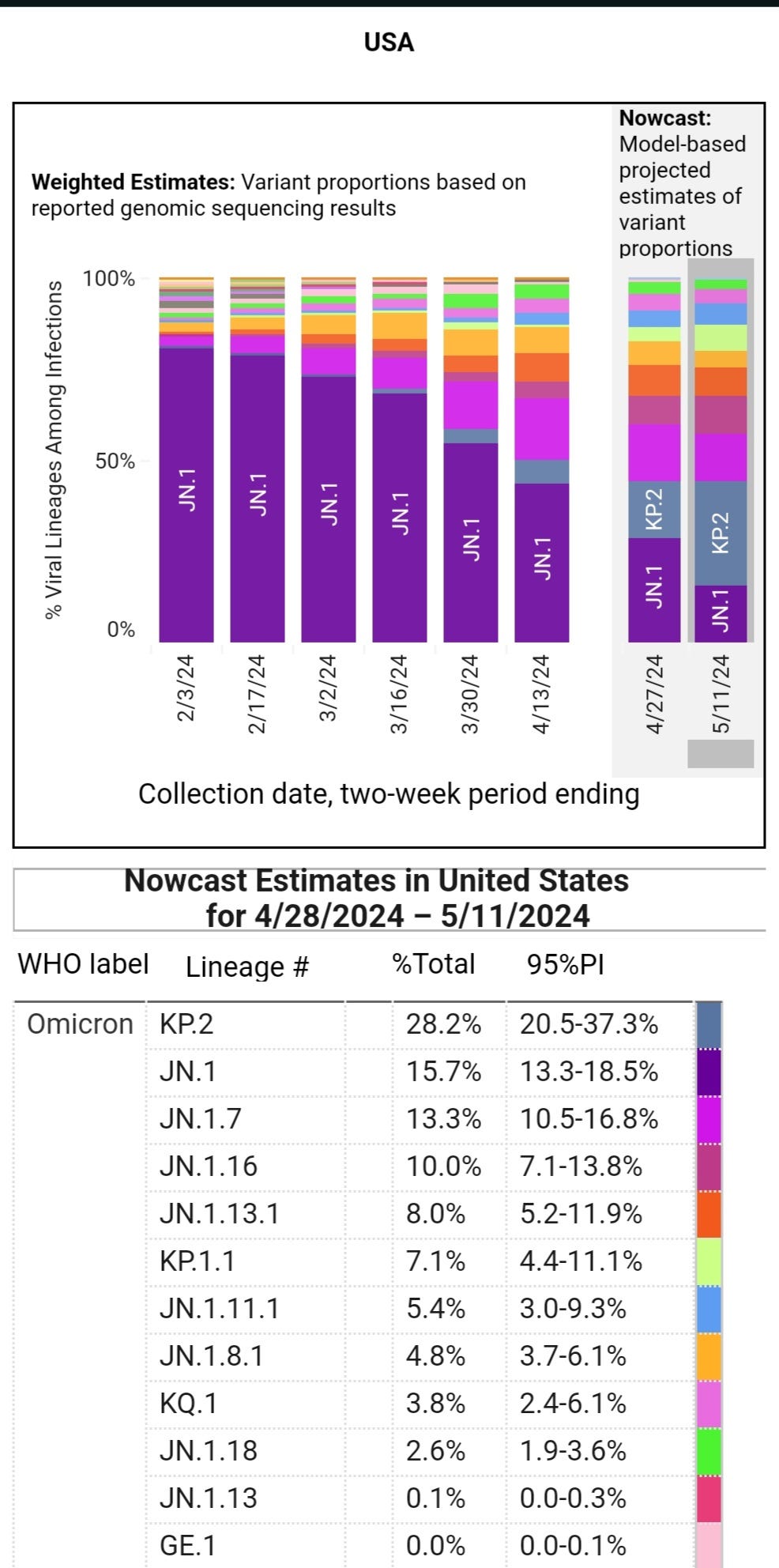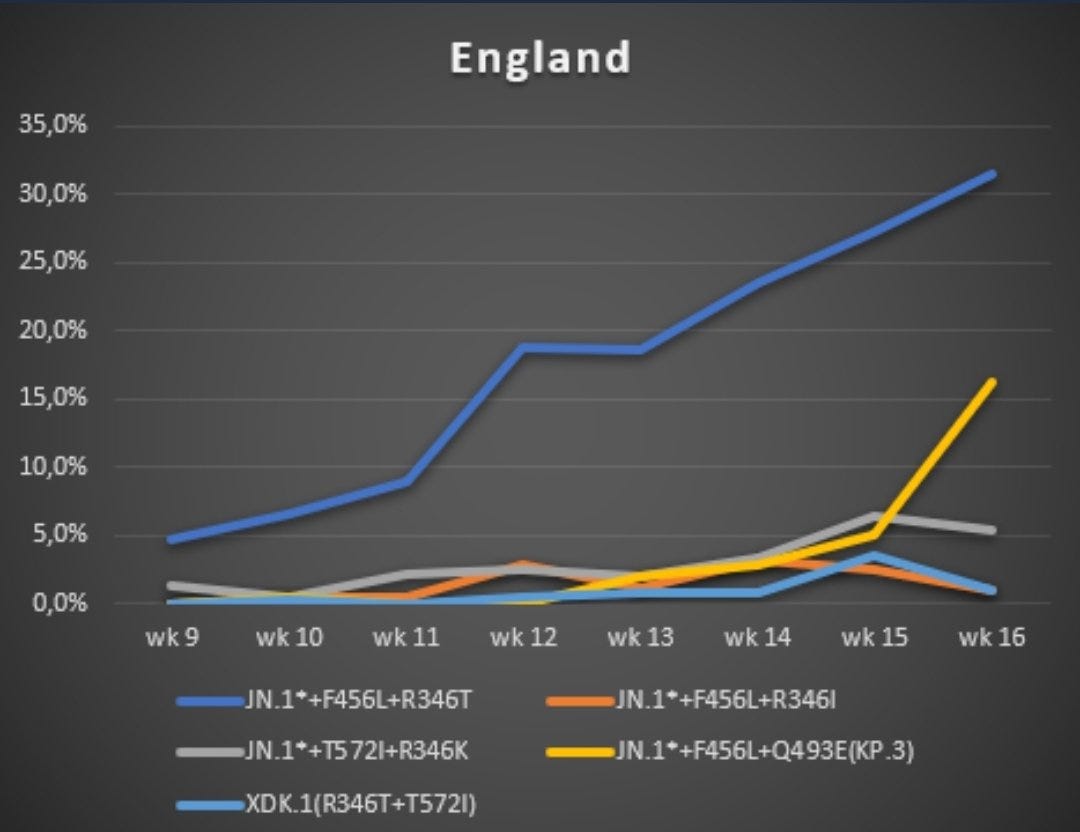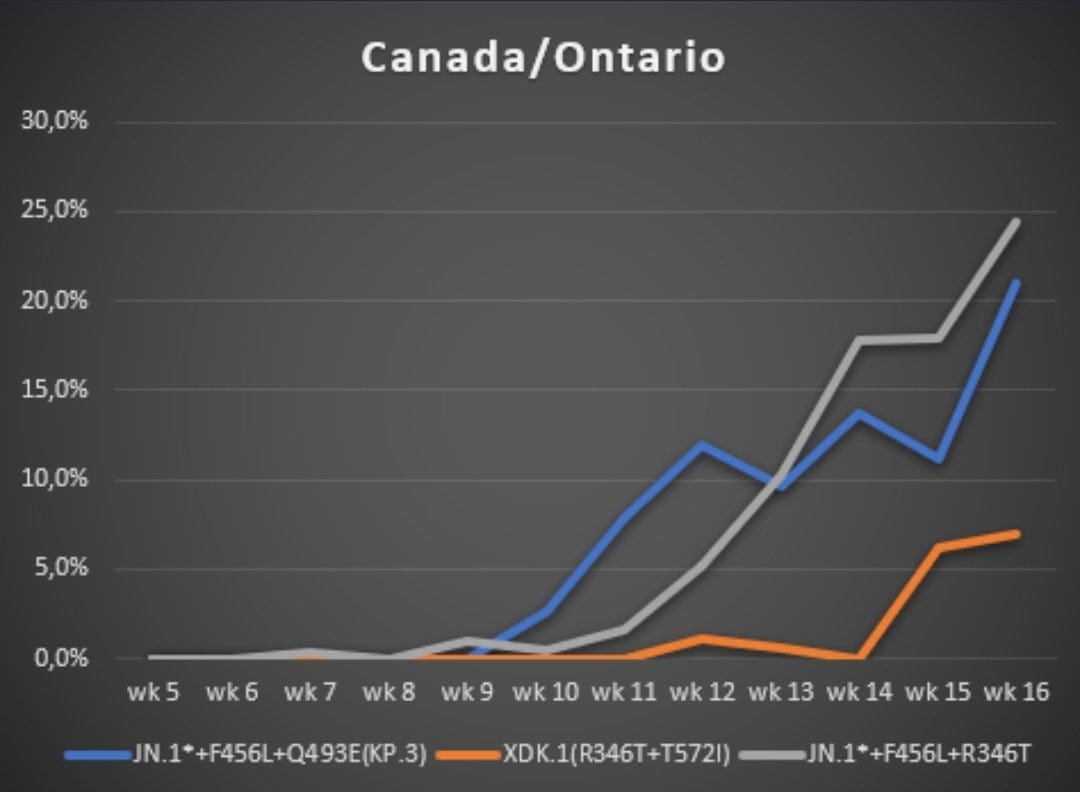COVID: Shifting Tides: The Emergence of KP.3 in the Shadow of KP.2's Dominance. What's Driving KP.3's Rapid Growth?
KP.3's Ascent Raises Alarms.

KP.2 variants continue to gain momentum as shown in the latest CDC variant proportions. KP.2.3 still has the greatest growth advantage according to the numbers but KP.3 has seemingly attained a new advantage. Currently, KP.3 has an 80% growth advantage, compared to KP.2.3's 97% GA.
KP.3 with the F456L+Q493E mutations. KP.3 removed the RT from Flirt, by deleting the R346T mutation. We’ll dig into what’s going on with KP.3 further down in this update. What we discovered is cause for serious concern.
The latest CDC variant proportions show that KP.2 is continuing to gain momentum, driven by some of its offspring. Mainly KP.2.2 and KP.2.3. These variants will likely become over 50% of all variants over the next two weeks.
The Rise of KP.3 with the S: Q493E Mutation
KP.3 is experiencing the most rapid increase in Canada, Australia, and Japan. While its growth seems slower in the U.S., this could be due to the latest version not yet becoming firmly established. Notably, KP.3 has acquired mutations distinct from those found in KP.2 or KP.2.3.
KP.3 has been sequenced in many U.S. states already and is likely more widespread than this map reflects.
In the graphic below, the yellow line depicts the trajectory of KP.3. As you continue reading this article, you'll uncover the likely catalyst behind the surge in KP.3's prevalence starting from week 15.
In the Ontario, Canada graphic below, KP.3 is represented by the blue line. A parallel trend emerges from week 15 onwards. A probable explanation for this trend hints at concerning implications for human health.
We'll be exploring numerous studies but simplifying the findings for easier understanding. To uncover more about what's driving KP.3, and the potential implications to our health subscribe below for free. Paid subscribers gain instant access, while free subscribers will receive an access-granting email within 3 days.
By subscribing, you’re helping support:
Unbiased reporting: We cut through the noise and deliver critical information you need to make informed decisions about your health.
In-depth analysis: TACT goes beyond headlines to uncover details and the true impact of COVID, Bird Flu, Monkeypox, and other emerging or evolving diseases.
Empowering insights: We translate complex scientific data into actionable knowledge, putting you in control of your well-being.
Support Independent Journalism - Become a Paid Subscriber Today!
The Rise of KP.3 with the S: Q493E Mutation
First, we will look at the Q493E mutation, then we will look at the more insidious mutation. We have quite a few studies on the 493 position but not on how switching the amino acid at position 493 with glutamic acid (E), will impact the virus. Nonetheless, the studies provide a lot of insightful information as to how it may impact the virus, so it is worth looking into. Here are some highlights.
Q: Refers to the amino acid glutamine (Q) that is normally present at position 493 in the spike protein.
R: Refers to the amino acid arginine (R) that replaces glutamine in the Q493R mutation.
E: Refers to the amino acid glutamic acid (E) that replaces glutamine in the Q493E mutation.
Impact of the mutation:
The change from glutamine to glutamic acid can potentially impact the virus in several ways:
Antibody binding: The spike protein's receptor-binding domain (RBD) is the target for many neutralizing antibodies. Mutations at position 493 could alter the RBD's shape and affect how effectively antibodies bind to the virus. This could reduce the effectiveness of certain antibody therapies or vaccines.
Viral transmission: Changes in the RBD could also influence the virus's ability to bind to the ACE2 receptor on human cells, potentially affecting its transmissibility or infectivity.
Immune escape: If the mutations allow the virus to evade the immune system more effectively, it could lead to reinfections or reduced vaccine efficacy.
Research Study on Q493K in Mice
Note: This is Not the Q493E in KP.3 but this can provide some insight into how it may impact the virus and our immune response.
In this study, scientists wanted to understand how a specific mutation in the SARS-CoV-2 virus affects mice. They passed the virus through mice several times to make it adapt better to them.
The mutated virus, called WBP-1, showed that it could infect mice more effectively and caused more severe lung problems, known as interstitial pneumonia.
The researchers discovered that a specific mutation called Q493K, located in a part of the virus that attaches to cells, played a significant role. This mutation made it much easier for the virus to bind to mouse cells. We don’t know how Q493E could impact people but this adds some insight into potential implications.
More information from the study.
Q493K and Q498H Substitutions in Spike Promote Adaptation of SARS-CoV-2 in Mice:
In this study, researchers aimed to create an ideal animal model for studying SARS-CoV-2 pathogenesis and evaluating therapies and vaccines. They passaged SARS-CoV-2 in BALB/c mice to obtain a mouse-adapted virus strain.
The mouse-adapted strain, called WBP-1, showed increased infectivity in mice and led to severe interstitial pneumonia.
The researchers characterized the dynamics of adaptive mutations in SARS-CoV-2 and found that Q493K and Q498H mutations in the receptor-binding domain (RBD) significantly increased its binding affinity towards mouse ACE2.
Need for further research:
While the study on the Q493K mutation provides some insights, more research is necessary to understand the specific effects of the Q493E mutation on the virus and its impact on disease progression, treatment response, and vaccine effectiveness.
ORF9b: P3H Mutation in KP.3
ORF9b: P3H was initially identified within the KP.3 variant in early April. By the end of April, it had become present in 100% of the sequences analyzed. This mutation does not appear in the KP.2 variants. This suggests a correlation between the emergence of this mutation and the rising prevalence of KP.3. Correlation isn’t necessarily causation but it certainly warrants further investigation.
Could this mutation be the critical factor granting KP.3 a competitive edge over other variants?
While we lack direct studies on this specific mutation, existing research sheds light on the role of the ORF9b protein in affecting the human immune system.
Let’s take a look.
Understanding How SARS-CoV-2 ORF9b Suppresses Immune Response During COVID-19
SARS-CoV-2, the virus that causes COVID-19, has certain proteins that can interfere with the body's immune response. One of these proteins, called ORF9b, is known to block a key part of the immune system called interferon (IFN), which helps fight viruses. ORF9b does this by targeting specific proteins in our cells, essentially putting the brakes on our body's ability to defend against the virus.
During the early stages of COVID-19, when people might not show many symptoms, the virus takes advantage of this weakened immune response to spread more easily. As the disease progresses, some patients develop severe symptoms like acute respiratory distress syndrome (ARDS) and a strong inflammatory response. Even though the body tries to fight back inflammation, the production of interferon is still blocked by proteins like ORF9b, contributing to the severity of the disease.
Researchers suspect that SARS-CoV-2 has evolved different strategies to dampen the immune system at different stages of infection. One potential approach to combating COVID-19 is to develop vaccines using modified versions of the virus that lack these immune-suppressing proteins like ORF9b, which could help the body mount a more effective defense against the virus.
Reference: SARS-CoV-2 ORF9b inhibits RIG-I-MAVS antiviral signaling by interrupting K63-linked ubiquitination of NEMO (February 2021) https://www.ncbi.nlm.nih.gov/pmc/articles/PMC7857071/
The Orf9b protein of SARS-CoV-2 modulates mitochondrial protein biogenesis
Imagine your cells as tiny factories with different departments. One important department is the mitochondria, the powerhouse that provides energy for the cell. SARS-CoV-2, the virus that causes COVID-19, has a sneaky protein called Orf9b that messes with this department.
Orf9b acts like a troublemaker, targeting a specific door (Tom70) on the mitochondria's surface. By blocking this door, it prevents the cell from sending out warning signals about the virus, allowing the virus to spread undetected. Newer versions of the virus, like Delta and Omicron, are even better at this trick, making them harder for our immune system to fight off.
But Orf9b does more than just silence the alarms. It also changes how the mitochondria operate, causing some parts to work less efficiently. This is like the troublemaker messing with the factory's machines, but surprisingly, it doesn't shut down the factory completely.
Think of it like this: If the virus produces a million copies of itself in a single cell, and there are only about 50,000 doors on the mitochondria, every single door gets blocked. This means that the virus is not just turning off the mitochondria, but carefully adjusting its activity, possibly for its own benefit.
This research shows how sneaky SARS-CoV-2 can be, using Orf9b to manipulate our cells for its own survival. Understanding these tricks is important for developing new treatments and vaccines to fight COVID-19.
Here are the associated quotes from the study referenced with the reference to the study below.
“Orf9b targeting Tom70 prevents MAVS oligomerization and activation on the mitochondrial surface and sabotages the antiviral signaling in cells infected with SARS-CoV-2. More evolved forms of the virus such as the Delta or Omicron variants even improved the Orf9b binding to Tom70, which apparently is a crucial element in their enhanced immune evasion.”
“We observed that Orf9b expression caused a considerable modulation of the mitochondrial proteome, thereby depleting many mitochondrial proteins.”
“Since one infected human cell was estimated to produce between 100,000 and 1,000,000 virions, which is higher than the copy number of Tom70 (37–58,000 per cell), the levels of Orf9b should be high enough to saturate all Tom70 binding sites.”
“This suggests that Orf9b does not mute mitochondrial biogenesis in general but rather modulates it. Despite the reduced volume of mitochondria observed in Orf9b-expressing cells, we did not observe a reduced growth or fitness of the Orf9b-expressing HsTom70 cells, contrary to other mutants of the import system, which often are severely compromised.”
Reference: The Orf9b protein of SARS-CoV-2 modulates mitochondrial protein biogenesis (September 08, 2023) | Journal of Cell Biology | Rockefeller University Press (rupress.org) https://doi.org/10.1083/jcb.202303002
It's important to note that these studies were conducted on previous variants and that we do NOT know the impact of the ORF9b: P3H mutation in the KP.3 variant. We need more research ASAP, but these studies give insight into how this mutation could be giving the KP.3 variant an advantage.
N:G204P
N:G204P was found in B.1.1.7
“We evaluated 948,077 SARS-CoV-2 Alpha variant genomes available as of 30 June 2021. One specific B.1.1.7 sub-lineage with two extra mutations—nucleoprotein G204P (N_G204P) and ORF8 K68stop (Orf8_K68stop) - was detected in thirty-five European countries with 62,225 genomes shared on GISAID.”
Reference: “Emergence and spread of a sub-lineage of SARS-CoV-2 Alpha variant B.1.1.7 in Europe, and with further evolution of spike mutation accumulations shared with the Beta and Gamma variants” (February 14, 2022) https://www.ncbi.nlm.nih.gov/pmc/articles/PMC9048873/
TACT’s Overview:
COVID-19 is evolving at an unprecedented rate. More mutations are happening in the body of the virus, suggesting it is evolving new strategies to evade and infect other aspects of the immune system and other cells throughout the body and brain.
Neglecting this reality will only lead to increased suffering and loss of life. We must adopt aggressive proactive measures to curb the transmission of this virus. The likelihood of more individuals experiencing persistent infections is rising due to these variants. The potential for millions to develop long-term health issues, known as Long COVID, is a very serious reality. Millions grappling with Long COVID may face worsening symptoms with these variants.
We can tackle the spread of the virus by enhancing ventilation and air filtration in indoor spaces, effectively reducing viral load. Moreover, on airplanes, which have been notorious for spreading new variants globally, implementing measures such as thorough ventilation and air filtration during boarding and disembarkation, while the engines and air systems are turned off, can significantly curb transmission. These actions aim to minimize people's exposure to viral particles, ultimately enhancing their chances of avoiding persistent infections.
This pandemic has been and still is predictable and it is preventable. We must work Together Against COVID Transmission.
By subscribing, you’re helping support:
Unbiased reporting: We cut through the noise and deliver critical information you need to make informed decisions about your health.
In-depth analysis: TACT goes beyond headlines to uncover details and the true impact of COVID, Bird Flu, Monkeypox, and other emerging or evolving diseases.
Empowering insights: We translate complex scientific data into actionable knowledge, putting you in control of your well-being.
Support Independent Journalism - Become a Paid Subscriber Today!













Thank you for continuing to update us about sarscov2. I have long covid…I have constant rosy cheeks as covid remains in my body.
So many people may have long covid or are damaged by covid and not know it. One of my best friends has stage 4 lung cancer- she never smoked. Of course her oncologist told her that wearing a mask is bad for her health and that it is not possible that her cancer was caused by Covid.
I told her that her oncologist is wrong…but she believes her oncologist from Kentucky- and not me..
Sigh…in the end it doesn’t matter if I am
Right- her life will be shortened by 20
Yrs…and I will
Miss her